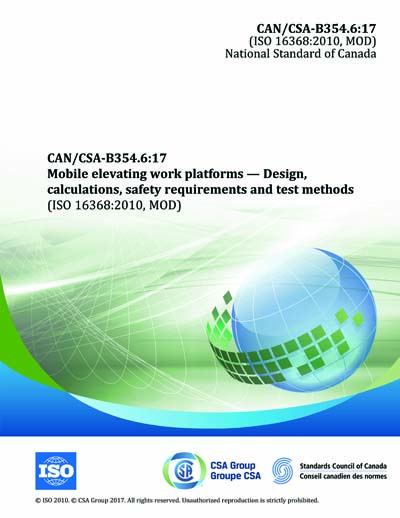Historical
CAN/CSA B354.6-2017
CAN/CSA-B354.6:17 - Mobile elevating work platforms - Design, calculations, safety requirements, and test methods (Adopted ISO 16368:2010, second edition, 2010-05-15, with Canadian deviations)
CSA Preface
This is the first edition of CAN/CSA-B354.6, Mobile elevating work platforms - Design, calculations, safety requirements, and test methods, which is an adoption, with Canadian deviations, of the identically titled ISO (International Organization for Standardization) Standard 16368 (second edition, 2010-05-15). It replaces the design, calculations, safety requirements and test methods sections of CAN/CSA-B354.1-04, Portable elevating work platforms; CAN/CSA-B354.2-01, Self-propelled elevating work platforms; and CAN/CSA-B354.4-02, Self-propelled boom-supported elevating work platforms. For brevity, this Standard will be referred to as CAN/CSA-B354.6 throughout. The Canadian deviations contain revisions and additional guidance to reflect Canadian practices and safety considerations. Note: It is recommended by the CSA Technical Committee that the requirements of this Standard be implemented within 12 months after the date of publication of this Standard. CSA gratefully acknowledges that the development of this Standard was made possible, in part, by the financial support of Canadian government departments responsible for occupational health and safety standards.Scope
This International Standard specifies safety requirements and preventive measures, and the means for their verification, for all types and sizes of mobile elevating work platforms (MEWPs) intended for moving persons to working positions. It gives the structural design calculations and stability criteria, construction, safety examinations and security tests to be applied before a MEWP is first put into service, identifies the hazards arising from the use of MEWPs and describes methods for the elimination or reduction of those hazards. This International Standard is not applicable to a) permanently installed personnel-lifting appliances serving defined levels b) fire-fighting and fire rescue appliances c) unguided work cages suspended from lifting appliances d) elevating operator position on rail-dependent storage and retrieval equipment e) tail lifts f) mast-climbing work platforms (see ISO 16369) g) fairground equipment h) lifting tables with a lifting height of less than 2 m i) builder's hoists for persons and materials j) aircraft ground-support equipment k) digger derricks l) elevating operator positions on industrial trucks m) under-bridge inspection and maintenance devices n) certain requirements for insulating aerial devices on a chassis for use in live work on electrical installations. It does not cover hazards arising from - use in potentially explosive atmospheres - use of compressed gases for load-bearing components - work on live electrical systems. NOTE 1 Hazards arising from work on live electrical systems are addressed in IEC 61057. MEWPs equipped with certain non-conductive (insulating) components can provide some protection from hazards associated with inadvertent contact with such systems (see ISO 16653-2). NOTE 2 For MEWPs that employ aerial devices used for live working, this International Standard will need to be used in conjunction with IEC 61057, taking into consideration the potential exceptions from this International Standard that are specified in IEC 61057. 1DV.1 Modify Clause 1 by replacing the last sentence of the first paragraph with the following: It gives the structural design calculations and stability criteria, construction, safety examinations and security tests to be applied before a MEWP is first put into service. 1DV.2 Modify Clause 1 by adding the following: Within this Standard, where ISO 16369 is referenced, this Standard will be considered to meet the intent of ISO 16369. Within this Standard, where IEC 61057 is referenced, CAN/CSA-C225 will be considered to meet the intent of IEC 61057. Within this Standard, replace responsible entity with manufacturer. Within this Standard, where ISO 18893 is referenced, CAN/CSA-B354.7 will be considered to meet the intent of ISO 18893. Within this Standard, where ISO 18878 is referenced, CAN/CSA-B354.8 will be considered to meet the intent of ISO 18878. 1.1DV Add the following subclause to Clause 1: Purpose The purpose of this Standard is to achieve the following objectives: a) the prevention of personal injuries and accidents; b) a uniformity in ratings; and c) to provide criteria for the design, manufacture, remanufacture, rebuild/recondition, testing, and performance of MEWPs. 1.2DV Add the following subclause to Clause 1: Terminology for Canadian deviations In this Standard, shall is used to express a requirement, i.e., a provision that the user is obliged to satisfy in order to comply with the standard; should is used to express a recommendation or that which is advised but not required; and may is used to express an option or that which is permissible within the limits of the standard. Notes accompanying clauses do not include requirements or alternative requirements; the purpose of a note accompanying a clause is to separate from the text explanatory or informative material. Notes to tables and figures are considered part of the table or figure and may be written as requirements. Annexes are designated normative (mandatory) or informative (non-mandatory) to define their application.CSA America, Inc. [csa]

